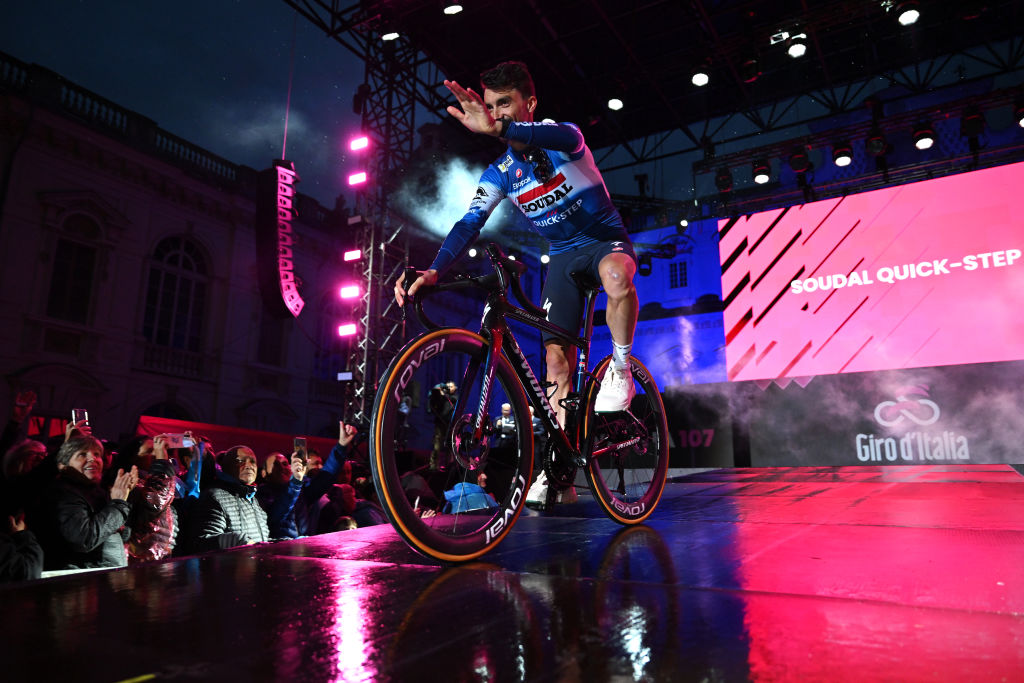
Julian Alaphilippe went to assess the lay of the land on Thursday afternoon. From the passenger seat of a Soudal-QuickStep team car, he performed his recon of stage 1 of the Giro d’Italia, a winding journey that took him through the Colline del Po, the hills to the southeast of Turin’s city centre.
The Frenchman would have learned relatively little about Superga and the Colle Maddalena that couldn’t already have been gleaned from the Garibaldi, the Giro’s lovingly detailed roadbook. Of greater use, however, was the drive up the late, unclassified climb to San Vito.
Saturday’s stage was initially slated to hug the south bank of the Po in the finale, a configuration that seemed to lend itself to a bunch sprint. In mid-winter, however, RCS Sport had second thoughts about whether their race’s opening act promised quite enough sparkle. A shade under 5km from the finish, the route now swings right, away from the river and up the hillock towards San Vito.
The road climbs for 1.4km at a shade under 10%. 400m from the top, the gradient briefly pitches up to 16%. The summit is a breathless 3km descent from the finish line on Turin’s Corso Moncalieri. The first man to San Vito, in other words, has every chance of wearing the first maglia rosa of this Giro. With a mountaintop finish to come at Oropa on Sunday afternoon, it might be Alaphilippe’s only chance to wear pink on his Giro debut.
“The first stage suits me well,” Alaphilippe told reporters on Friday afternoon in Turin. “It’s a hard stage, a short stage and it’s nervous too. I really like this kind of day. I’m super motivated. I think Sunday will be too hard for me, but Saturday is a good day to try.”
In Alaphilippe’s imperial phase between 2019 and 2021, he would have been the soaraway favourite to punch clear on a climb like the Bivio di San Vito. On the opening weekends of the 2020 and 2021 Tours de France, for instance, he took full advantage of such terrain. Everybody knew what was coming and still they were powerless to prevent it from happening.
He has done it on Italian roads in the past, too. At the 2020 Worlds in Imola, for instance, Alaphilippe understood that winning the race to the top of the Cima Gallisterna would likely net him the rainbow jersey, and so it proved.
Back then, Alaphilippe was bracketed alongside Tadej Pogacar in a select group of riders operating on a different plane to the rest of the peloton. Over the past two and a half years, however, Alaphilippe has slipped out of that elite cadre, while Pogacar, Mathieu van der Poel et al have zoomed off into the horizon.
In the build-up to this Giro, there has been plenty of chatter about the prospect of Pogacar winning in Turin and leading this race from start to finish. Alaphilippe’s chances on a finale seemingly tailored to his talents have been rather less trumpeted. Then again, that’s hardly a slight. Alaphilippe’s 2024 season has been subdued to this point, with his Classics campaign hindered – though not halted – by the knee he fractured at Strade Bianche.
Alaphilippe’s Giro debut meant that he missed the Ardennes Classics this year, opting instead for a period of rest after finishing a distant 70th at the Tour of Flanders. He returned to action at the Tour de Romandie last week, placing third in the opening time trial before running up and down his scales for the remainder of the race.
“I think the shape is good,” Alaphilippe said. “Romandie was an important week for me, to race hard and put some big efforts in the legs. I think I cannot do better preparation than that. This last week was only about recovery, to try to be fresh for the next three weeks. It’s hard to say how my condition is, but I feel good and I’m ready to suffer. I think this is important.”
High stakes
In those halcyon days at the turn of the decade, Alaphilippe developed the useful habit of being a man for the big occasion. He had appeared listless in the second half of the 2020 Tour, for instance, but in hindsight, he was perhaps simply bubbling under ahead of the Imola Worlds. Twelve months later, he conjured up a similarly feat of alchemy to carry off another gold medal in Leuven.
“I really kept it simple before the Giro,” Alaphilippe said of his preparation for the corsa rosa. “I wasn’t on a training camp at altitude, nothing like that. I just took a break after the Tour of Flanders, and I trained quite basically just to have good shape. Then Romandie was good for me. I was not exceptional, but I improved day by day and that was a good sign.”
It remains to be seen, however, if Alaphilippe’s calm build-up will lead to the kind of thunderous performance he used to deliver as a matter of routine on finales like this. This season, after all, he has been hitting headlines more for the admonishments of Soudal-QuickStep manager Patrick Lefevere rather than for his results.
He is, however, still only 31 years of age and on the radar of a number of French teams when his deal with Soudal-QuickStep expires at season’s end. The first maglia rosa of the Giro would be a useful bargaining chip in the ongoing negotiations. The stakes are high.
“I have a chance, but I don’t know how big that chance is,” Alaphilippe said. “I have more of a chance with a parcours like tomorrow than with Sunday, so I will try to take this chance. It’s about the legs. It will not be a big surprise tomorrow. You need to be strong and explosive. I just hope I can enjoy the stage, give my best and have no regrets.”







